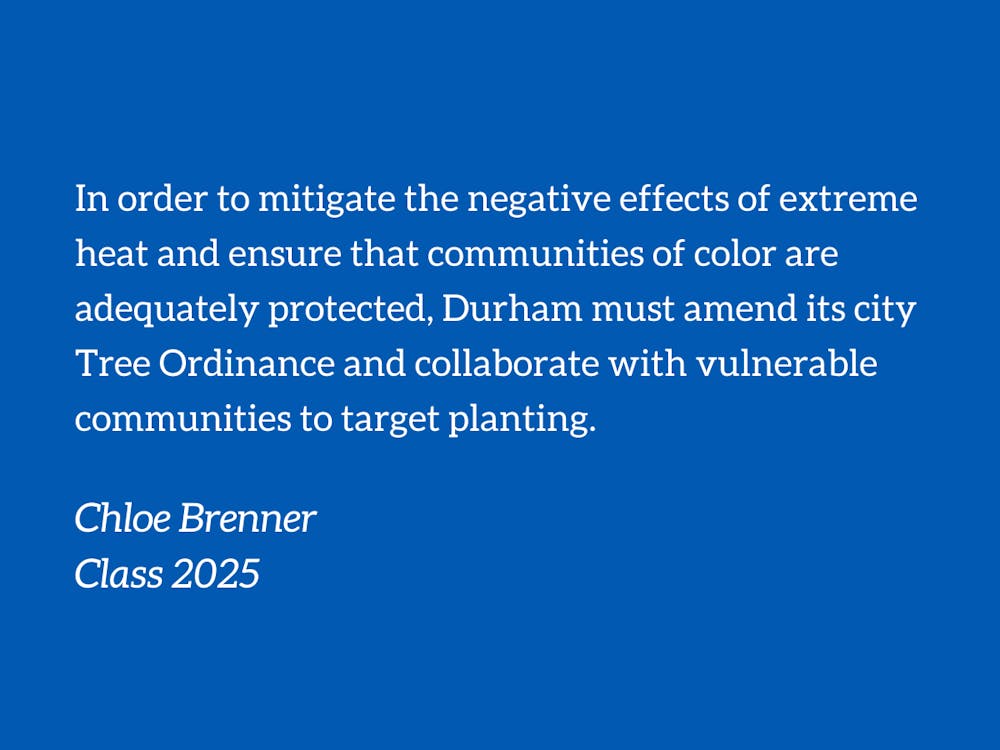As of August 2022, extreme heat was the leading cause of weather-related deaths in the US. High summer temperatures can trigger severe heat stress and exhaustion among other serious health issues. This phenomenon is called the “urban heat island effect” (UHI), and it occurs when land cover, vegetation and tree canopy — which cools surrounding areas by providing shade — are sparse compared to heat-absorbing surfaces such as cement and asphalt.
However, extreme heat does not affect all neighborhoods equally. Because of historic practices of systemic disinvestment and redlining, many Black and Brown neighborhoods in the US lack adequate tree canopy and therefore face greater vulnerability to extreme heat.
Durham, a previously redlined Southern city, unsurprisingly has an extreme heat problem that disproportionately burdens communities of color. Durham’s temperature can vary by as many as 10 degrees in the summer between neighborhoods. An EPA study conducted in 2018 found that Durham must target tree planting in eight “vulnerable” neighborhoods — including Old East Durham, Lyon Park and Walltown. Maps indicate large swaths of city blocks in these areas with less than 10% tree canopy. This barren landscape stands in stark contrast to the luscious and old canopy shading the high-rent Trinity Park and Duke Park neighborhoods.
Durham officials are and should be concerned about extreme heat, as the effects of climate change threaten to increase already steamy summer temperatures. In order to mitigate the negative effects of extreme heat and ensure that communities of color are adequately protected, Durham must amend its city Tree Ordinance and collaborate with vulnerable communities to target planting.
This year, the city proposed a revision to its Tree Protection Ordinance, which governs rules about tree coverage requirements for new development. This amendment seeks to increase minimum canopy coverage requirements by a few percentage points across the city and county. This means that when developers propose plans, they must meet higher minimum requirements to receive approval. Even though this revision might sound productive, it falls short of effectively addressing the undue burden of extreme heat facing Durham’s Black and Brown communities.
History has taught us that we cannot simply expect public services to reach all residents equally. In fact, the Urban Institute argues that race-blind climate policies in particular threaten to reinforce existing environmental inequities. Because equity and the urban heat island effect are not explicitly mentioned in the Tree Protection Ordinance’s revision, it is unlikely that it will significantly target tree planting in vulnerable neighborhoods. As Durham revises its city ordinances, it must take steps to prioritize tree planting where residents need it most.
First, the proposed Tree Ordinance amendment must be revised to address the urban heat island effect. Consider the precedent set by peer cities Atlanta and New Orleans. Both cities mention extreme heat and equity in their tree ordinances. Atlanta’s ordinances require that “heat islands” receive “planting priority” and New Orleans includes “reducing the heat island effect” as part of its zoning regulations. The full impacts of these policies remain to be seen, but simply including extreme heat in city ordinances would give Durham officials more latitude to take action. For example, including the UHI in city ordinances might enable officials to challenge clear-cutting or new development that requires tree removals. Leveraging the city’s ordinances is essential.
In addition, Durham officials should increase outreach to residents in the communities identified as lacking tree canopy. Understanding the specific needs of community members is critical to implementing sustainable and just solutions, so Durham should create opportunities for residents to convene with city officials and share their experiences. In these spaces, neighbors could relay which areas should receive the highest priority because of community necessities such as walkability and outdoor gathering spaces. Residents know what their communities need best, and collaborating with them is likely to produce more equitable and sustainable outcomes.
Ultimately, increasing tree canopy across Durham’s communities, particularly in communities of color, is an urgent matter of community well-being. Not only do trees reduce temperatures and protect residents from heat-related illness, but they also shield residents from flooding and low air quality because of their absorption of stormwater and air pollutants. If the environmental benefits weren’t enough, trees boost our mental health by lowering stress and improving cognition. Durham residents stand to benefit greatly from tree planting, but these efforts must first be rooted in equitable city policies.
Chloe Brenner is a Trinity sophomore studying Environmental Science and Public Policy.
Get The Chronicle straight to your inbox
Signup for our weekly newsletter. Cancel at any time.

